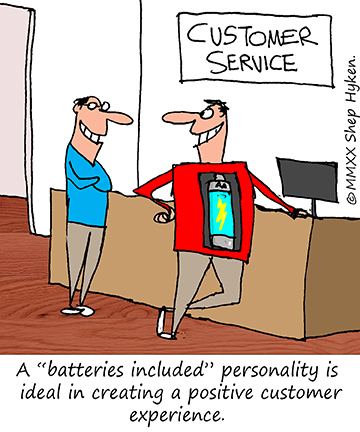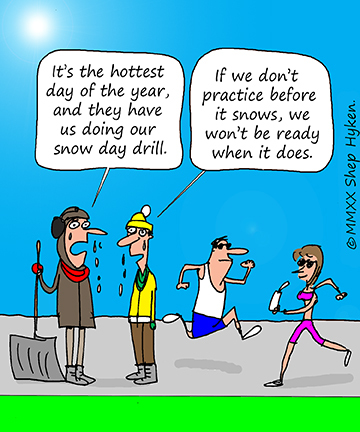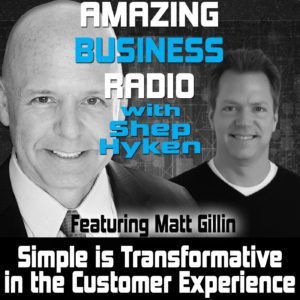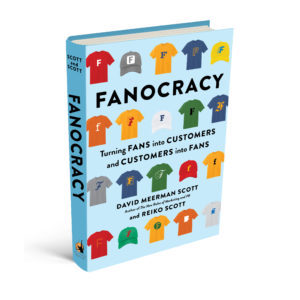Shep Hyken's Blog, page 112
January 24, 2020
Guest Post: The Secret to Stand-Out Store-Level Customer Service
This week we feature an article by Brett Patrontasch, CEO of Shyft. Brett provides three insightful ways to help improve customer satisfaction and employee empowerment.
Most retail businesses understand that the best service strategies won’t succeed if store-level employees don’t feel motivated.
When given proper training, support, and encouragement, employees can make your business. If service seems to lag, you might take a look at your service strategy – as well as employee engagement strategy.
More often than not, bad customer service can be attributed to employee ambivalence. Usually, the reality of the issue can be summarized in one sentence: A lack of employee empowerment.
A Dale Carnegie study found that companies with high employee engagement outperform those without it by 202%. And yet, a separate report from Deloitte found that less than a quarter of companies believe they offer excellence in this area.
So, how do you encourage your retail business to stand out by creating a company culture that employees feel invested in while offering top of the line customer service?
Here are three ways you can boost employee empowerment and engagement to increase customer satisfaction and provide a stand-out store experience.
1. Empower Your Staff to be Efficient and Flexible
Any business with customer service needs to learn to expect the unexpected. At any given moment, a customer can approach an employee member with an unusual or unique question or concern.
Empower your staff with the autonomy to make important decisions and provide them with the tools necessary to remain flexible. Relying on outdated processes like paper schedules and manual shift swapping will create a more rigid culture and a precedent of running every decision by management.
According to a study by Aberdeen, companies with engaged employees experience a 233% greater customer loyalty and 26% revenue increase.
Engaged and empowered employees help your business reach new and greater possibilities with your customers. All you need to do is provide them with the support and encouragement to help them think on their feet and make those possibilities happen. Scheduling is one example where staff should be encouraged to make the changes they need to be as engaged and available as possible. Using up-to-date tools can help support that initiative and give managers the potential to be more hands-off.
2. Encourage Tech-Usage
With a smartphone in nearly everyone’s pocket these days, customers have the chance to be better informed than staff.
By equipping your store-level employees with the latest technology for communication and task management, you increase their mobility and empower them to be as effective as possible. Mobile solutions provide an array of capabilities to support associates’ working lives, such as communication, shift swapping, inventory management, and more.
Empowering staff through technology allows staff to create an in-store experience that’s as smooth and effective as your store’s website – while appealing to the Gen Zs and millennial staff and customers.
3. Unification is The Name of The Game
Gathering actionable information from other departments, then applying that information to everyday support information is key.
While technology and self-motivating encouragement are two ways to increase staff empowerment and therefore customer service quality, providing staff with as much information as possible while bringing together all interactions and data into one place are important factors.
This teamwork effect helps streamline customer interactions, making every situation straightforward for both staff and the customer.
Successfully applying actionable information from multiple departments gives your staff the chance to make better decisions while fueling cross-team collaboration. To do this, make sure communication between all departments is open and geared towards the same outcome: a happy and loyal customer base.
Bonus: Helping Staff “Be Themselves”
While maintaining a professional approach to customer service is always a top priority, if you’re setting the right example, you can achieve this while also empowering your staff to “just be themselves.”
When staff feel empowered to be themselves, they’re also happier. And, according to a study at the University of Warwick, happier staff are 12% more productive.
What’s more, when staff feel encouraged to be themselves, creativity levels are also likely to rise as they’re able to share their ideas and opinions with the team and customers. This boosts innovation and changes the store environment in a positive way for everyone present.
One way to directly affect this is through the company’s culture in terms of how it fosters communication – from etiquette to processes and tools that collectively help staff feel supported by their team, increase chemistry, and boost team morale. Giving your employees a way to communicate in and out of the workplace is a great way to get them feeling comfortable around each other and helping to improve productivity.
Your Takeaway
In this modern age, customer behavior is constantly evolving – which demands new ways of developing and strengthening your relationship with them.
However, sometimes, the answer simply lies internally, within the very people who are interacting with customers on a daily basis. If you want your customers to feel the “WOW” factor every time they interact with your brand, ensure your frontline employees are empowered to take charge of their own schedules, better engage with customers and team members, and deliver the best possible experience for everyone.
The secret to memorable retail store customer service can be found in strategies that involve empowering and engaging your staff – developing and upholding one of the core foundations your business leans on.
Brett Patrontasch is CEO and co-founder of Shyft , the mobile-first workforce management solution empowering hourly workers to trade shifts, manage their schedules, and communicate with their teams. Brett is passionate about improving the lives of hourly workers and leading teams to develop high-quality product design and best-in-class user experiences .
F
 or more articles from Shep Hyken and his guest contributors go to customerserviceblog.com.
or more articles from Shep Hyken and his guest contributors go to customerserviceblog.com.
Read Shep’s latest Forbes article: Transform The Customer Experience
The post Guest Post: The Secret to Stand-Out Store-Level Customer Service appeared first on Shep Hyken.
January 22, 2020
Batteries Included
 “There are two kinds of people: Batteries Included and Batteries Not Included.”
“There are two kinds of people: Batteries Included and Batteries Not Included.”
That quote comes from Dan Sullivan, founder and president of the Strategic Coach program. If you’ve been following my work, you’ll probably recognize his name. I’ve learned a lot over the years by attending his workshops and coaching sessions. He recently released a book that included many of his quotable words of wisdom. This one—about Batteries Included or Batteries Not Included—resonated with me. If it doesn’t already resonate with you, I bet it will in just a moment.
I have what appears to be an endless amount of energy. Yes, I sleep, but I like to get up and go. People have often compared me to the Energizer Bunny, as I just seem to go and go and go. There’s no doubt I’m a “Batteries Included” kind of guy, and I like spending time with others who come with Batteries Included. Words and phrases I would use to describe this type of person include self-starters, willing to take charge, doers, motivated, up for a challenge, willing to step outside their comfort zone and more. You get the idea.
Then there are Batteries Not Included kind of people. Words and phrases to describe that type of person include negative, pessimistic, little initiative, complainers and energy vampires. That last one is ugly. The old phrase, “They can suck the energy out of the room,” comes to mind here.
Who would you rather be around or work with? (That’s a rhetorical question.) What type of person gets regular or accelerated promotions? What type gets more sales? I could ask a host of similar questions, but it doesn’t take long before you realize that a Batteries Included personality is a good thing, especially in the working world.
Here’s something important to remember. You don’t have to be the Energizer Bunny, full of life and energy, to be thought of as Batteries Included. You don’t have to have an outgoing, gregarious, life-of-the-party personality. What you do need is a certain type of energy—the type that adds to whatever is happening instead of taking away from it. You must, at minimum, have a joy for what you do, a desire to make things better, a willingness to be open-minded and—this one’s big—the mindset of a contributor.
That’s what Batteries Included people do. They contribute. They add. Batteries Not Included people detract and take away. Ask yourself which category you fall into. If your batteries aren’t already included, find ways to inject that energy into everything you do. You can start small. I guarantee it will make a world of difference for both you and the people you do business with.
Shep Hyken is a customer service expert, keynote speaker, and New York Times bestselling business author. For information, contact 314-692-2200 or www.hyken.com. For information on The Customer Focus customer service training programs, go to www.thecustomerfocus.com. Follow on Twitter: @Hyken
customer service training programs, go to www.thecustomerfocus.com. Follow on Twitter: @Hyken
(Copyright © MMXX, Shep Hyken)
The post Batteries Included appeared first on Shep Hyken.
January 21, 2020
Amazing Business Radio: Jim Gilmore

Excellent Service in an Experience Economy
How to Create an Experience That Wins Customers
Shep Hyken interviews Jim Gilmore. They discuss the new edition of The Experience Economy: Competing for Customer Time, Attention, and Money, which Jim co-authored with Joseph Pine.








Top Takeaways:
The economy has evolved over time from an agrarian economy to an industrial economy, then to a service economy and finally to an experience economy, where the experience a customer has is the most valuable component.
Service and experience are two different but related things. Service is what you as the company do. Experience is the customer’s time and perception of the interaction and relationship that occurs through that service.
Experience goes beyond the product being sold to customers. A good example of this is Starbucks. They are able to sell coffee at a premium because of the ambiance, environment, and relationship they create for and with their customers.
Customization and personalization are key components in staging an experience. Customers today want to spend less time with goods and services, but will spend more time with events and places that engage them with a personalized and memorable experience.
Today, every business must compete against the smartphone for customers’ attention. It allows customers to instantly disengage from a place, product or service.
People are consuming experiences today in smaller chunks, which can be referred to as the miniaturization of consumption. People may not take large vacations, but they do seek out and take “mini-vacations” that last just an hour—or two or three. It may be in the form of a fun afternoon at an escape room or even spending time in a coffee shop.
Experiences are inherently personal and differentiated. Challenge yourself to constantly see things anew through the lens of the customer. This ensures you’re delivering the best possible experience all around.
Quotes:
“Time is the currency of experiences. If you get people to spend more time with you, they will spend more money with you.”
“Every business today faces the same number one competitor: the smartphone. If you are not engaging people in a compelling way, they can leave you with the mere swipe of a screen, and then they’re gone.”
“There’s a fundamental difference between time well saved and time well spent.”
“Service is what you do. The experience is the customer’s time.”
“Commodities, goods and services exist outside of people. Experiences occur inside people. They are inherently personal and different from person to person.”
About:
Jim Gilmore is co-founder of Strategic Horizons LLP. He has authored and co-authored several books, has been published in many leading business publications, co-edits Markets of One and teaches/lectures at several colleges and universities.
Shep Hyken is a customer service and experience expert, New York Times bestselling author, award-winning keynote speaker, and your host of Amazing Business Radio.
The post Amazing Business Radio: Jim Gilmore appeared first on Shep Hyken.
January 20, 2020
5 Top Customer Service Articles For the Week of January 20, 2020
Each week I read a number of customer service and customer experience articles from various resources. Here are my top five picks from last week. I have added my comment about each article and would like to hear what you think too.
Customer Effort Score or Customer Satisfaction? by Martin Powton
(CustomerThink) Customer Effort Score is a popular metric used to measure customer service satisfaction using one single question. The principle behind this is that companies create loyal customers by reducing customer effort.
My Comment: “Customer Effort” is a great way to measure the convenience of when a customer needs to connect with a company for help or to have a problem solved. The insight won’t tell you if your customers love you or not, but it will give you an idea of how efficient you are in managing the support experience. When you make it easy – as in minimal or no effort – to get a problem resolved, you increase your customer’s confidence.
How to Run a Customer Loyalty Program by ThriveHive
(ThriveHive) This article will give you a run-down on the basics of customer loyalty marketing and programs, how they work, and how you can use them to retain more customers with your business.
My Comment: While a short article like this may not be all you need to start and run a customer loyalty program, this is a good start to get you thinking about the type of program you might consider. The author shares five compelling reasons to have a program and a description of several different types of loyalty programs.
Loyalty Trends in 2020: How Will This Year Be Different? by Wise Marketer Staff
(The Wise Marketer) We are fans of mapping out industry trends and predictions at the beginning of each year. It’s part of our mandate as the voice of the global Loyalty Marketing industry, but we recognize that our list is just one among dozens of others. So, how is our perspective for our loyalty trends in 2020 formed to make it worth your reading time?
My Comment: Following up on the last article about loyalty programs, here’s another. This time with trends of what customers are enjoying – or not – in their loyalty programs. As you read the article, consider whether what you want is a true loyalty program, one that drives connection and customer loyalty, or if you want to have a marketing program (points, awards, etc.), which drives repeat business. Both are great strategies. Just be aware of the difference.
Merge Lanes: Four Tips To Integrating AI Into Your Customer Service Workflow by By Leonie Brown
(Forbes) Managing the handoff points between man and machine can be a challenge. This article shares five strategies that can help smooth the transition.
My Comment: This is a very short article, but with several very good points. The premise is that there are two sides to the AI argument regarding human contact versus automated self-service. My opinion has been AI can’t replace the human experience (at least not yet), but it can support it. And, what I most appreciate about this article is the second point, where AI supports the customer service agent – not the customer.
Travel Megatrends 2020: Subscription Travel Is the Next Frontier of Loyalty by Andrew Sheivachman
(Skift) The travel industry tends to view its products as a must-have for consumers. This mindset has led the sector to lag behind the entertainment and e-commerce world when it comes to building lasting relationships with digital-first consumers.
My Comment: While this article focuses on the travel industry, the main topic is around the subscription model. There are many companies out there (B2B and B2C) that have not given enough consideration to a subscription model. One of the author’s comments summarize why this model works: Consumers who buy into subscription services are committed beyond just a one-time purchase…
BONUS
Live Chat Benchmark Report 2020 Comm100 Network Corporation
(Comm100) How do you measure your team’s impact and success? See how you stack up against others in your industry.
My Comment: In the customer contact/support center, live chat is a hot topic. This is the fifth report from Comm100 about how chat is being used to support customers. Some interesting stats and facts are included. If you’re involved with customer support, you’ll enjoy this article. It’s “gated” so you’ll have to provide your name and email, but it’s worth it.
 Shep Hyken is a customer service expert, professional speaker and New York Times bestselling business author. For information on The Customer Focus
Shep Hyken is a customer service expert, professional speaker and New York Times bestselling business author. For information on The Customer Focus customer service training programs go to www.TheCustomerFocus.com. Follow on Twitter: @Hyken
customer service training programs go to www.TheCustomerFocus.com. Follow on Twitter: @Hyken
The post 5 Top Customer Service Articles For the Week of January 20, 2020 appeared first on Shep Hyken.
January 17, 2020
Guest Post: How One Bold Move Helped this Firm Survive (and Thrive!) in The Great Recession
This week we feature an article by Bill Cates, author of Beyond Referrals, Radical Relevance, and the founder of The Cates Academy for Relationship Marketing. He shares an example of how one company was able to flourish during the Great Recession.
In the summer of 1999, two teenagers changed the music business almost overnight … and forever. The code written by Sean Parker and Shawn Fanning enabled people to download music at no cost. Illegal? Yup! Innovative and popular enough to spread like a wildfire? You bet!
The introduction of Napster was a trigger event for an entire industry. In an article for Mic.com, Tom Barnes writes, “Napster forced the music industry to develop digital distributions and streaming technology, which it could have done far earlier. Had the industry developed that technology instead of attempting to suppress it, artists may not have had to shoulder the massive economic fallout that they have. Luckily, artists won’t bear that burden forever; streaming offers both the benefits of instantly accessible music and an increasing amount of pay.”
Similar examples abound. The debut of Netflix permanently altered how people consume television. The roll-out of Amazon Prime turned the retail industry on its head. I don’t know about you, but Uber seemed to come out of nowhere. In just a few short years, this company’s name has become a verb. “You can just Uber over to the restaurant.” Do you think the taxi industry sees the emergence of Uber and similar services as a trigger event? You betcha.
“Toto… We’re not in Kansas anymore.”
Speaking of trigger events, perhaps you remember the Great Recession? Technically starting in December of 2007, the housing market collapsed, sending many homes into foreclosure, and many real estate agents and mortgage originators looking for new employment. While maybe a few economists and industry observers saw this coming, most didn’t. Most were taken by surprise.
While writing my latest book, Radical Relevance, I had the fortune of having breakfast with Craig Strent, CEO of Apex Home Loans (headquartered in Maryland and doing business across 5 states). Craig is an extraordinary businessperson, creative thinker, and life-long learner who has taken his business to levels most mortgage companies only dream about.
I asked Craig how the Great Recession impacted his business, and the mortgage industry as a whole.
Craig stated: “Sometimes, change to an industry can come so fast that you’ll wake up one day and wonder what planet you’re on.” He then became super serious, adding “We must always be ready and willing to justify, defend, or reframe our value to our prospects and customers, or we’ll die a fast death in the marketplace.”
From Service to The Experience
As I furiously took notes, I asked Craig to elaborate. He said, “What differentiates our business is our commitment to building a long-term relationship with the client, something that is often ignored in the mortgage industry.”
Craig went on to say, “I tell my clients, ‘If you work with me, you’ll never worry about your mortgage again. We send quarterly reports letting you know whether or not it’s time to refinance. We manage your mortgage for you.”
Craig is certainly correct … the mortgage industry isn’t known for the quality relationships they form with their clients. Between purchases and refinancing, I’ve probably done about nine mortgages in my lifetime. The only loan officer I remember is a former neighbor, who isn’t in the business anymore. The behavior of most loan officers would suggest that they see themselves in a transactional business – pretty much competing on price alone (that they don’t even set) – and they assume that’s how the rest of the world sees them.
Refusing to Look Like All the Rest
By refusing to approach their business in the same way as their competitors, Craig and his partners not only weathered the economic storm that hit them hard, they slowly but surely began to grow. About the growth of his company, Craig said to me, “In what many perceive as a commodity-based business, we have grown exponentially, because we have built a business model designed to deliver a better experience for our clients.”
“Better experience?” I asked. “I’m guessing you mean something more than just better good customer service. Tell me more.”
Replied Craig, “Our mission is this: We deliver a superior home financing experience through a better mortgage process and lifelong mortgage management. Once we committed to this mission, we couldn’t just let it be empty words. We had to deliver.”
“We must always be ready to justify, defend, or reframe our value to our prospects and customers or we’ll die a fast death in the marketplace.” -Craig Strent, CEO, APEX Home Loans
Put Your Money Where Your Mouth Is
So, how exactly does Apex deliver on this promise of a better client experience?
Enter Steve Dorfman. I actually met Craig through Steve a few years back, when he contacted me to purchase 45 copies of my book Beyond Referrals and hire me for a workshop for Apex’s 45 Loan Officers and Mortgage Planners.
Steve’s role at Apex? Chief Experience Officer.
Now I ask you, how many small to mid-size companies have a Chief Experience Officer? Heck – how many companies of any size go beyond delivering quality customer service to providing a great customer experience?
Dorfman knows that a company’s ability to provide a great customer experience starts with the employee work experience. Dorfman told me once, “How a company interacts with its employees will determine how its employees interact with the customers. The external experience that we are able to provide to our customers is a reflection on our own internal culture of a great work-place experience.”
Steve is always on the lookout to install systems that ensure employees appreciate the experience of working for Apex Home Loans and that their customers always appreciate the experience of doing business with them.
Says Craig, “Without question, this shift and commitment to delivering a better experience is the single most important thing we’ve done to create a thriving business. Our prospects tell us that they can feel the difference from the very beginning and our customers can’t believe that we are really staying in touch with them to keep the experience and value coming.”
Don’t Get Trapped in Commodity Thinking
Whether you are in a business that feels like a commodity business or not, you can employ this same thinking to rise above the noise to get noticed and grow. Businesses trapped in “commodity thinking” pay attention to client satisfaction. Businesses who separate themselves, pay attention to client experience.
Regarding the growth of his business, Craig’s said to me, “Bigger is not better, better is better and bigger just came along for the ride.”
Bill Cates is the author of Beyond Referrals, Radical Relevance, and the founder of The Cates Academy for Relationship Marketing. Subscribe to his free referral tips and other free resources at: www.ReferralCoach.com/resources. To learn more about how Bill might impact your business, go to www.ReferralCoach.com or email your questions or interest directly at BillCates@ReferralCoach.com.
F
 or more articles from Shep Hyken and his guest contributors go to customerserviceblog.com.
or more articles from Shep Hyken and his guest contributors go to customerserviceblog.com.
Read Shep’s latest Forbes article: Fraud Is Eroding The Customer Experience
The post Guest Post: How One Bold Move Helped this Firm Survive (and Thrive!) in The Great Recession appeared first on Shep Hyken.
January 15, 2020
Your Emergency Response Plan—Be Prepared
 One of our Shepard Letter subscribers, Tom Korff, wrote in with an important question: how should customer support agents handle callers who are threatening to harm themselves and/or others?
One of our Shepard Letter subscribers, Tom Korff, wrote in with an important question: how should customer support agents handle callers who are threatening to harm themselves and/or others?
This is a serious topic. I will share my thoughts, but it’s important to note that the brevity of my answer does not diminish the importance of the question. If someone threatens to do harm to themselves or others, it cannot be taken lightly.
If you find yourself in this situation, the first step is to inform the customer that such statements are taken seriously and that you will be informing the proper authorities. It’s important to make this statement with as much concern and empathy as possible. Of course, the follow-through is just as, if not more, important. You cannot make that statement without following through on your actions. Once any imminent danger has been dealt with, take time to reflect. Determine how a situation like this should be handled and then create a process for crisis management. The process should include informing management and contacting the appropriate authorities. Train everyone in your organization how to respond using this process. Training is important to ensure consistency.
While Tom’s question was focused on how to respond in a customer support center, this situation could happen to anyone in almost any department. The key is knowing what to do if and when it does. Again, everyone must know how to respond.
This brings us to a bigger question: What other situations require company-wide training? While not quite as extreme as a customer doing harm to themselves or others, your employees should know what to do during a power outage. Do you have a game plan for snow days? What if the air conditioning goes out on the hottest day of the summer? On a more serious note, does everyone know what to do when the fire alarm goes off? There are plenty of emergency situations where everyone should be trained on how to respond.
By the way, you’re not finished once everyone is properly trained. Repeat training is the only way to ensure everyone is ready to react. Fire drills and other role play should be done regularly to reinforce how to handle extreme issues. For some cases, you may consider repeating these training exercises and drills every six months.
So, make your list. Write out what needs to happen. Get the process on paper and train… and then train again. You never know when you might face one of these situations. When that does happen, you’ll want to be prepared!
Shep Hyken is a customer service expert, keynote speaker, and New York Times bestselling business author. For information, contact 314-692-2200 or www.hyken.com. For information on The Customer Focus customer service training programs, go to www.thecustomerfocus.com. Follow on Twitter: @Hyken
customer service training programs, go to www.thecustomerfocus.com. Follow on Twitter: @Hyken
(Copyright © MMXX, Shep Hyken)
The post Your Emergency Response Plan—Be Prepared appeared first on Shep Hyken.
January 14, 2020
Amazing Business Radio: Matt Gillin

Simple is Transformative in the Customer Experience
Revolutionizing Communication So It’s Personalized, Secure, and Effortless
Shep Hyken interviews Matt Gillin. They discuss the secrets of driving customer loyalty and a good customer experience (CX). Here’s a hint: it’s all in providing a secure, personalized, and frictionless channel of communication.








Top Takeaways:
The biggest challenge facing business today is how to more effectively engage and connect with customers. Companies must find innovative solutions if they hope to overcome this obstacle and find success.
Every organization’s goal should be to get their customers to say, “Wow, thank you!” Customers expect this now more than ever before in addition to a more personalized experience.
The best way to connect and engage with customers is through a channel that is personalized, on-demand, secure, and most importantly, frictionless. If your customer’s experience is not easy, they will not remain loyal to you or your brand.
A technical advantage alone is not enough to satisfy and delight your customers. Make sure you invest in your core services and customer engagement. That is what will ensure a competitive advantage for your company.
It can be difficult for businesses to make the shift to a better customer experience due to legacy systems, infrastructures, and thinking. Solutions must also be easy and frictionless.
Information and the channel through which it is delivered must be relevant to customers. Customers resist technology and AI when it is not relevant, secure, or personalized to them.
There must always be a human element in each relationship. Customers want to do business with companies that know them and that allow for effortless communication.
The goal should always be to create a better connection with your customers. At the end of the day, that’s what drives a good CX and customer loyalty.
Quotes:
“The world is now on-demand and highly personalized. The secret of the game is to make it easy and frictionless.”
“If you’re not delighting your customers, if you’re not making things easy for them, they will not be your customers for long.”
“When you know your customers and maintain flowing, frictionless lines of communication, that’s when you win as an enterprise. That’s when customers stay”
About:
Matt Gillin is the CEO and co-founder of Relay Network, a Gartner-designated “Cool Vendor” in CRM Customer Service and Support. He has over 20 years of experience as an active entrepreneur, pioneer and inventor.
Shep Hyken is a customer service and experience expert, New York Times bestselling author, award-winning keynote speaker, and your host of Amazing Business Radio.
The post Amazing Business Radio: Matt Gillin appeared first on Shep Hyken.
January 13, 2020
5 Top Customer Service Articles For the Week of January 13, 2020
Each week I read a number of customer service and customer experience articles from various resources. Here are my top five picks from last week. I have added my comment about each article and would like to hear what you think too.
What Does it Take to Lose a Customer? by Anthony Cusumano
(CMSWire) Customer experience. It’s a term that meant little to organizations even 10 years ago, and even now might still elicit eye rolls from executives.
My Comment: The title of this article caught my attention. There are some good insights and ideas here, and after reading the article, you may think the title should have been, “What Does It Take to NOT Lose a Customer.” You’ll read three ideas, and the second is my favorite, which focuses on creating advocacy, not loyalty.
4 Things to Automate In 2020 for Better Customer Relationships by Nathan Resnick
(HubSpot) Customer relations should always be a top priority for any business. And, with 2020 arriving, now is a good time to find new solutions that meet the needs of your target audience.
My Comment: How can an automated experience build a relationship with a customer? To start with, consider that some type of automation (AI, chatbots, etc.) can take care of the simpler routine tasks, thereby freeing up the team to focus on higher-level issues and connect with customers. The third idea is to use webinars. While I wouldn’t consider that an automated experience, it’s still a digital experience – and a good one at that!
Four Ways To Boost Customer Experience (And Thus Hold Onto Your Clients) by Ryanne Van Der Eijk
(Entrepreneur Middle East) To remain competitive and ensure sustainable growth, it is vital that every area of your business focuses on customer satisfaction as a priority.
My Comment: Here’s another list of four good ideas. They will remind you of some customer experience basics, starting with a journey map. As common-sense as this may seem, I’m surprised at the number of my clients that haven’t take the time to go through one of the most important steps of building a strong CX. That’s the first strategy on the list. Read the article to find out the other three.
Resolving Complaints And Keeping Your Retail Customers In The Process by Glenn Taylor
(Retail TouchPoints) How you handle customer complaints often determines if you build or lose relationships with busy shoppers. This is especially true online where retailers often rely on remote contact center agents to resolve things.
My Comment: First, while the title implies this is for retail customers, it reaches far beyond most customers in any type of industry (B2C and B2B). Here are some very good ideas on how to manage an unhappy or complaining customer. It’s not rocket science, but it doesn’t have to be. Pay attention to number four, which is about learning from the experience. When you breakdown a bad experience, you often learn how to prevent it from happening again – or at least reduce the likelihood of it happening again.
Resolutions That Last all Year — for You and Your Customer Service Department by Priyanka Tiwari
(CMSWire) In the interest of kicking off 2020 on the right foot, here are a few best practices for keeping your personal and professional resolutions going strong.
My Comment: The new year is not even two weeks old, so it’s not too late to create some “resolutions.” While I’m not a big fan of resolutions, that doesn’t mean we can’t set some goals and expectations for the year (and beyond). Here are a few good ones to consider, but don’t stop there. Let this article be a springboard to coming up with a few more “resolutions” to help you and your organization create the best CX and service possible.
 Shep Hyken is a customer service expert, professional speaker and New York Times bestselling business author. For information on The Customer Focus
Shep Hyken is a customer service expert, professional speaker and New York Times bestselling business author. For information on The Customer Focus customer service training programs go to www.TheCustomerFocus.com. Follow on Twitter: @Hyken
customer service training programs go to www.TheCustomerFocus.com. Follow on Twitter: @Hyken
The post 5 Top Customer Service Articles For the Week of January 13, 2020 appeared first on Shep Hyken.
January 10, 2020
Guest Post: Turn Customers into Fans by Telling the Truth, Especially When It Hurts
This week we feature an article by David Meerman Scott who has written a new book, Fanocracy: Turning Fans into Customers and Customers into Fans about turning customers into customers and customers into fans. He shares a couple of examples about how companies have used lying and “Fake news” to turn customers into fans.
Do you believe statements like “Your call is important to us” or “Due to higher than expected call volume, your wait time is longer than normal”? I sure don’t! Sadly, companies lie to customers all the time.
It also seems that not very many people believe what our leaders say. Politics has become theater. When politicians run for election, they make promises that they assume voters know they won’t keep.
Lying in public is now so widespread that some marketers even feel free to use it as a ploy to get attention. “Fake news” is so widespread it’s a joke.
IHOP: #IHOb and Lying to Your Fans
For example, social media exploded with the news, released June 4, 2018, that IHOP (International House of Pancakes) was to change their name a few days later to “IHOb” They made an announcement via a new verified Twitter feed at @IHOb:
“For 60 pancakin’ years, we’ve been IHOP. Now, we’re flippin’ our name to IHOb. Find out what it could b on 6.11.18. #IHOb”
“IHOb” retweeted an image of a crane replacing an IHOP sign with an IHOb one, making more plausible the idea they were changing their name.
Many IHOP fans shared their deep concern on social media. They wanted to know: What’s going on with the brand we love? Thousands of fans didn’t like the impending name change one bit and they said things on social media like:
• “IHOP is changing its name to IHOB and while people think it stands for “breakfast” I’m putting my money on BETRAYAL”
• “just found out ihop is changing their name to ihob and I feel like many of my constitutional rights are being violated”
• “IHOP JUST CHANGED IT’S NAME TO IHOB?! THEY ARE FAMOUS FOR PANCAKES, MAN. PANCAKES!”
Many mainstream media outlets were sucked in and published stories about the impending name change including The Washington Post, Florida’s Sun-Sentinel newspaper, Yahoo, CNN, and several local ABC and CBS network-affiliated television stations.
Then, on June 11, 2018, IHOb, er… IHOP let the world know the answer.
“Just kidding!”
They admitted they weren’t really going to change their name. It turns out it was simply a stunt to get social media talking about the fact that you can go to IHOP for more than just breakfast and, oh yeah, they now have burgers too.
It turns out that for IHOP, lying was a strategy. However, with this approach to business, they repelled fans—their best customers.
The idea of messing with the truth when communicating with the loyal fans of your company and its products is deception—not good business. And not the way to build what I call a Fanocracy.
Over the course of many interactions taking months or years, a customer learns what a brand stands for. In the case of a restaurant, the brand also becomes such things as cleanliness, the demeanor of the staff, the quality of the food, and much more. Over dozens of visits that could span decades, generations of people come to know the kind of experience to expect. The relationship between a brand and its customers is a complicated one. Building trust takes time.
KFC: The Chicken Restaurant that Ran Out of Chicken
It was a #KFCCrisis! A chicken restaurant without any chicken!
One otherwise fine day in 2018, KFC ran out of chicken in the UK. KFC had changed logistics companies and the new provider fouled up the fowl deliveries.
KFC could have ducked the chicken problem or hid behind gobbledygook words or blamed the logistics company, the sorts of actions we expect. Instead of the typical response, KFC did a wonderful job communicating on social networks and via advertisements, using humor to get people interested but providing valuable information to their fans, those who frequent the company’s restaurants.
In UK newspapers, the company ran full-page advertisements cleverly changing the KFC logo on a chicken bucket to FCK. One of the ads read:
We’re sorry. A chicken restaurant without any chicken. Huge apologies to our customers, especially those who traveled out of their way to find we were closed. And endless thanks to our KFC team members and our franchise partners for working tirelessly to improve the situation. It’s been a hell of a week, but we’re making progress, and every day more and more fresh chicken is being delivered to our restaurants. Thank you for bearing with us.
The company quickly created a website to provide a list of all UK restaurants and the chicken status of each. They also offered rewards to people affected via the company smartphone app.
On social media, the company was constantly providing updates, many with the fun approach of the ads.
Based on the reaction on social media, KFC did an excellent job handling this crisis. They were quick to communicate, they were transparent in telling customers what was happening, and they did so in an engaging way. And when chicken started being served again, all was forgiven.
KFC is turning customers into fans!
There is no other choice than, to tell the truth when your fans deserve to know what’s happening. You don’t gloss over the negative, you face it right off, you are clear and specific They are many different approaches to this including the humor we especially enjoy used by KFC.
David Meerman Scott spotted the real-time marketing revolution in its infancy. Now David says the pendulum has swung too far in the direction of superficial online communications. Organizations have learned to win by developing what he calls a “Fanocracy” – tapping into the mindset that relationships with customers are more important than the products they sell to them.
For more articles from Shep Hyken and his guest contributors go to customerserviceblog.com.

Read Shep’s latest Forbes article: Three Quotes That Inspire Great Leadership And Success
The post Guest Post: Turn Customers into Fans by Telling the Truth, Especially When It Hurts appeared first on Shep Hyken.
January 8, 2020
Smile and the World Smiles With You—Unless It’s Fake
 One of our faithful Shepard Letter subscribers emailed me a story. He was at a store, and the employee was friendly and engaging. But when he saw her later—when she was off duty—she acted indifferent toward him, almost rude. She wouldn’t even smile, which made him wonder, “Shouldn’t people greet you as warmly outside of their work environment as they do while on the job?”
One of our faithful Shepard Letter subscribers emailed me a story. He was at a store, and the employee was friendly and engaging. But when he saw her later—when she was off duty—she acted indifferent toward him, almost rude. She wouldn’t even smile, which made him wonder, “Shouldn’t people greet you as warmly outside of their work environment as they do while on the job?”
When you hire someone for a job, you should understand their personality. Do they come to the job with the positive attitude you want your customers to experience? Or do they have to “fake it”? The old cliché of “hire for attitude and train for skill” comes to mind, but I think it’s more than that. You do want to have someone with the right attitude, but more importantly, they need to understand and fit in with the culture and personality of your organization.
Just hours after I read this subscriber’s story, I was at the airport standing in front of the check-in desk at the gate. The gate agent was busy pecking away at the computer’s keyboard. He never once looked up at me. (Was I invisible?) He then left to go down to the plane. He came back a few minutes later and continued to work, never once looking at me or the other passengers that were now lining up behind me. Finally, I asked him, “Are you the gate agent working this flight?” He responded, “Yes, but this gate is closed until one hour before the flight.”
Good explanation… but it would have been nice for him to tell me that five minutes earlier. A nice friendly smile along with that explanation would have gone a long way. I walked away and found another agent who was not “officially” on duty or working my flight, but who was almost overzealously willing to help me. She was very friendly, so I complimented her. I then told her the story about the grumpy agent who wouldn’t even acknowledge me. I could tell that frustrated her, and she confided in me that he always comes to work with a sour attitude. She even said, “I can’t imagine why he keeps this job. He must hate it—having to be friendly to everyone. It’s not who he is.”
When it comes to hiring people who have to work with others, especially customers, trust me on this. If the job requires friendliness and an outgoing personality, you don’t want to hire someone who has to fake it. It’s just a matter of time before they flip back to a different personality. They may want to put forth their best effort, but if it really isn’t part of their personality, they will eventually revert back to who they really are. People can only adapt for so long.
It’s important to remember that customers don’t know whether an employee is on-duty or off-duty. But they do know how they are treated. Your best people should have the people-focused gene. It’s about who they are all the time, not just when they are at work and on duty. That’s who you want working for you—and that’s the company reputation you should strive for.
Shep Hyken is a customer service expert, keynote speaker, and New York Times bestselling business author. For information, contact 314-692-2200 or www.hyken.com. For information on The Customer Focus customer service training programs, go to www.thecustomerfocus.com. Follow on Twitter: @Hyken
customer service training programs, go to www.thecustomerfocus.com. Follow on Twitter: @Hyken
(Copyright © MMX, Shep Hyken)
The post Smile and the World Smiles With You—Unless It’s Fake appeared first on Shep Hyken.



